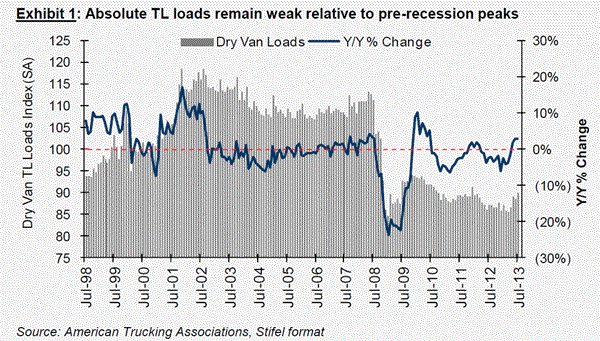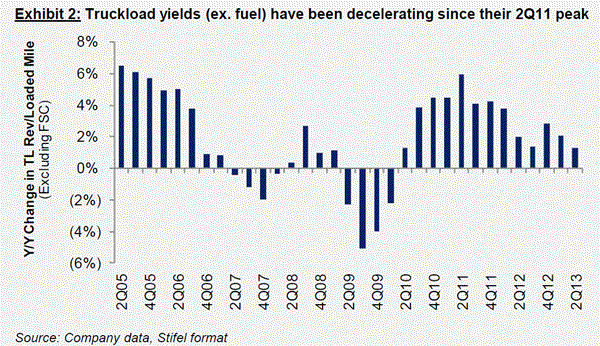From SCDigest's On-Target E-Magazine
- Sept, 11, 2013 -
Logistics News: In a Continued Mixed Market, US Truckload and LTL Rate Increases are Slowing
Rates Overall have Risen Just 1-2% in 2013, though Mid-Sized Shippers May be Taking More than Large Ones
SCDigest Editorial Staff
It continues to be a somewhat unusual environment for truckload and LTL shipping in the US, with freight volumes of late sluggish at best, but with carriers overall maintaining asset discipline such that the supply-demand balance is modestly in the carriers' favor.
SCDigest Says: |
 |
| Ross says those worst cases fears relative to the impact of HOS changes do not seem to be materializing. |
|
What Do You Say?
|
|
|
|
So say transportation sector analysts David Ross and Bruce Chan of investment and research firm Stifel Nicolaus & Company, in a recent research note.
While the American Trucking Associations Freight Tonnage Index has been setting all-time highs of late, that growth in volumes naturally varies by sector. For example, much of the total tonnage gains may be coming from the growth in oil shipments stemming from the explosion of production levels driven by fracking operations in places such as North Dakota and others.
Core dry van volumes, however, tell a different story. While there has been some modest growth in percentage terms in the past six months or so, total loads are well off all-time highs set in the early 2000s, and are more than 10% below volumes seen before the start of the recession in 2008, as shown in the graphic below from Stifel Nicolaus, which is also based on ATA data.
We'll note this disconnect between tonnage data and the number of dry van loads could also be partially explained by increased weight per truck from greater shipper trailer utilization efficiencies. Flatbed loads have also been increasing, while intermodal also continues to taking some dry van volumes away from truckload carriers, especially in the consumer goods sector, Ross and Chan note.
Core Dry Van Volume Growth has Just Recently Turned Positive

On the truckload side, a proxy for changes in rates is yield, or the revenue that carriers achieve per loaded ton mile. While truckload yields have been positive growth for the past 14 quarters based on the pool of public truckload carriers Stifel follows, growth has decelerated steadily since their 2Q11 peak to a very modest 1.3% year-over-year change in the second quarter, again as seen in the chart below. Ross and Chan note these results exclude fuel surcharges, so the trend reflects a degradation in core pricing momentum, as volume trends have stagnated.
Truckload Yields, a Good Proxy for Rates, have Been in Decline

On the LTL side, a similar story. Stifel says while most carrier management teams cited 3%-5% rate increases in their Q2 earnings calls, those comments "did not foot with the numbers [actually]reported."
(Transportation Management Article Continued Below)
|